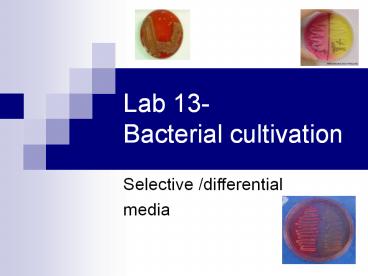Lab 13- Bacterial cultivation - PowerPoint PPT Presentation
Title:
Lab 13- Bacterial cultivation
Description:
Lab 13- Bacterial cultivation Selective /differential media Lab activities: Demo selective and differentiation plates Streaking bacteria on differentiation plates ... – PowerPoint PPT presentation
Number of Views:135
Avg rating:3.0/5.0
Title: Lab 13- Bacterial cultivation
1
Lab 13- Bacterial cultivation
- Selective /differential
- media
2
Lab activities
- Demo selective and differentiation plates
- Streaking bacteria on differentiation plates
3
Cultivation
- The process of growing microorganisms in culture
by taking bacteria from the infection site (in
vivo or environment) and grow them in artificial
environment in the laboratory (in vitro).
4
Growth needs
- Fastidious bacteria relatively complex growth
needs - Non-fastidious bacteria- relatively basic and
straightforward growth needs
5
Phases of growth media
- Broth- Growth of bacteria will change the liquid
from clear to turbid (cloudy). - Solid Agar plates, slants Bacterial cells
inoculated on solid media will multiply enough to
be seen by naked eye.
6
Colony- (clone)
- Colony- A bacterial population derived from one
bacterial cell. The cells within the colony have
identical, genus, species, genetic and phenotypic
characteristics. - Pure bacteria - derived from a single colony.
- Selection of a pure colony -most important for
bacterial identification
7
Media classification and function
- Enrichment Used to enhance growth of a
particular pathogen - Supportive - support growth of most non
fastidious bacteria
8
Media classification and function
- Selective - Contain inhibitory agents that are
inhibitory to all organisms except those sought - Differential - Contain factors that allow
bacterial species to manifest certain metabolic
characteristics that distinguish them from other
species. - Media can be both selective and differential
based on the ingredients of the medium.
9
Blood agar plate (BA)
- Nutrient agar with 5 sheep blood
- Cultivation of fastidious and non fastidious
bacteria. - Differential Identify hemolysis - Some bacteria
secrete enzymes that lyse red blood cells
(hemolysins) such that a clearing around the
colony appears. - b hemolysis- complete clearing (white hemolysis)
- a hemolysis incomplete clearing (green
hemolysis) - g hemolysis- no hemolysis
10
(No Transcript)
11
(No Transcript)
12
Mannitol Salt Agar (MSA)
- Both selective and differential medium.
- High salt concentration - inhibits most bacteria.
- Selective for Staphylococcus sp.
- Differentiate between Staphylococcus sp. by the
sugar mannitol fermentation . - Mannitol fermention produce acids that change
the medium pH. - Peach color- neutral- no fermentation
- Bright yellow- Acidic mannitol fermentation
(Staph. coag. pos.- Staph. aureus)
13
(No Transcript)
14
MacConkey Agar (MAC)
- Selective and differential medium.
- Selective - Gram positive bacteria are inhibited
by the presence of bile salts and crystal violet
inhibitors in the medium Most of gram negative
bacteria will grow. - Differentiate- Between Gram negative bacteria by
their ability to ferment lactose. - Pink colonies- Bacteria that ferment lactose
(precipitation of some salts in media by acid
production). - Pale colonies- Non fermenters
15
(No Transcript)
16
Eosine Methylene blue (EMB),
- Differentiatial between lactose fermenting and
non fermenting enteric bacteria
17
Tellurite Glycine Agar (TGA)
- Selective- Tellurite glycine and lithium inhibit
most bacteria - Preferential growth of Staphyloccoci coagulase
positive (Staphyloccocus aureus)
18
Bacteria streaked in lab
- Staphylococcus aureus
- Staphylococcus epidermidis
- Salmonella pullorum,
- E.coli
S.aureus
S.epidermidis
S.pullurum
E.coli
EMB and TGA































